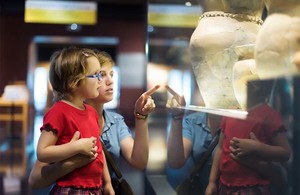Cultural venues to receive £128 million to improve access to arts and culture
Organisations are now being encouraged to submit expressions of interest to receive support

-
Access to arts and culture in areas with low levels of cultural engagement to be boosted through the £49.4 million Cultural Development Fund
-
Local library services to be improved with £15.5 million Libraries Improvement Fund
-
Urgent museum maintenance and infrastructure works to be funded through £63.3 million Museum Estate Development Fund
Cultural venues including museums, galleries and public libraries are to benefit from up to £128 million of funding to help improve accessibility to the arts and safeguard their futures.
Organisations are now being encouraged to submit expressions of interest to receive support following the previous allocation of £48 million worth of funding to 60 organisations earlier this year.
Venues across the country have already benefited from the fund including the Birmingham Museum & Art Gallery, which earlier this year received £5 million to fund structural work to safeguard the building for future generations, and Bletchley Park, which was given £468,000 for essential maintenance works to its buildings.
Funding of infrastructure projects at museums, improvements in local library services and investment in community-focused cultural sites will ensure that these cultural assets at the heart of communities will help regional economies and protect their unique local heritage for generations to come.
Support will be targeted to areas which have historically had lower levels of cultural investment as part of the government’s commitment to levelling up access to culture across the country.
Funding will be targeted on locally-led cultural projects, museums and public libraries in England.
Arts Minister Lord Parkinson said:
Cultural institutions form the heart of communities across the country and it is important that we provide them with the support they need.
This funding will help make culture more accessible to everyone, including people who may not have enjoyed its benefits before, as well as supporting vital maintenance work to secure the future of many venues. It is an important part of our plan to level up the country, for the benefit of everybody.
Darren Henley chief executive of Arts Council England said:
Artists, arts organisations, museums and libraries have the power to animate and energise villages, towns and cities in amazing and innovative ways.
This new investment in culture and creativity will help people across the country to enjoy happier lives.
Hedley Swain, CEO of the Royal Pavillion & Museums Trust in Brighton, which previously received £1.4 million through the first round of the Museum Estate and Development Fund, said:
We are so grateful to the Department for Digital, Culture, Media & Sport and Arts Council England for this important award from the Cultural Investment Funds, including Museum Estate and Development Fund (MEND). It will allow us to make urgent and timely repairs to the roof of Brighton Museum and Art Gallery allowing us to stay open and plan with confidence for the future. Additional funding will be provided by Brighton & Hove City Council to whom we are also deeply grateful. Brighton Museum is an important historic building in its own right, part of the Royal Pavilion estate. It’s so important that buildings like this are maintained for the benefit of current and future generations”.
Councillor Sue Smith, cabinet member for communities and cooperation at Rochdale Borough Council, which previously received £4,199,365 through the Cultural Development Fund, said:
The CDF funding means we can take forward our exciting plans for a new Rochdale Cultural District, bringing together our outstanding heritage and cultural assets to attract more visitors, create new opportunities for residents and to complement the growing town centre retail, food and leisure offer. We will also be creating a new cultural partnership to develop and deliver more projects across the borough, increasing opportunities for residents, creatives and creative businesses.
The Cultural Investment Fund covers the following three streams:
Cultural Development Fund
The £49.4 million Cultural Development Fund aims to give people access to arts and culture in areas with historically low levels of cultural engagement to help support economic growth. The fund helps transform cultural sites which are at the heart of communities such as Middlesbrough Council Cultural Services and Barnsley Museums.
Libraries Improvement Fund
The £15.5 million Libraries Improvement Fund will transform library services in England by helping them upgrade their buildings and improve digital infrastructure. Local authorities can bid for the money on behalf of their library services.
Museum Estate and Development Fund
The £63.3 million Museum Estate and Development Fund (MEND) helps fund urgent museum maintenance and infrastructure works beyond their day-to-day budgets. Arts Council England accredited museums in England that are not directly funded by DCMS can apply.
In March, £48 million was awarded to 60 cultural institutions in England through the first round of the Cultural Investment Fund, with venues including the London Transport Museum and Leicester Museum & Art Gallery receiving money. Sandwell Library and Information Service in the West Midlands was also awarded £495,000, while Berwick Barracks in Northumberland was awarded £4 million to turn it into a year-round cultural venue.
Ends
Notes to Editors
Museum Estate and Development Fund
These funds follow a number of other successful government interventions to support the UK’s cultural organisations. The £2 billion Culture Recovery Fund helped thousands of organisations survive the pandemic. Earlier this year the government also announced an additional £75 million of arts funding, which will be distributed by 2025 to places that have been culturally under-served in the past. This is part of its efforts to level up access to the arts through the highest level of investment by the taxpayer in culture in the post-war period.